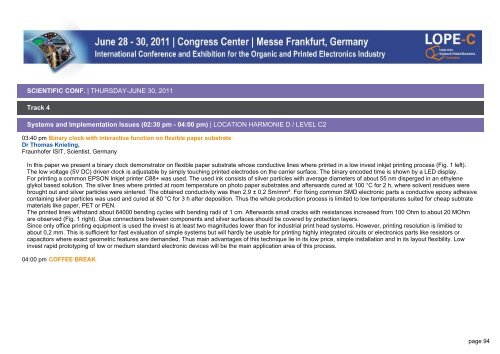Conference Program - LOPE-C 2011
Conference Program - LOPE-C 2011
Conference Program - LOPE-C 2011
You also want an ePaper? Increase the reach of your titles
YUMPU automatically turns print PDFs into web optimized ePapers that Google loves.
SCIENTIFIC CONF. | THURSDAY-JUNE 30, <strong>2011</strong><br />
Track 4<br />
Systems and Implementation Issues (02:30 pm - 04:00 pm) | LOCATION HARMONIE D / LEVEL C2<br />
03:40 pm Binary clock with interactive function on flexible paper substrate<br />
Dr Thomas Knieling,<br />
Fraunhofer ISIT, Scientist, Germany<br />
In this paper we present a binary clock demonstrator on flexible paper substrate whose conductive lines where printed in a low invest inkjet printing process (Fig. 1 left).<br />
The low voltage (5V DC) driven clock is adjustable by simply touching printed electrodes on the carrier surface. The binary encoded time is shown by a LED display.<br />
For printing a common EPSON Inkjet printer C88+ was used. The used ink consists of silver particles with average diameters of about 55 nm disperged in an ethylene<br />
glykol based solution. The silver lines where printed at room temperature on photo paper substrates and afterwards cured at 100 °C for 2 h, where solvent residues were<br />
brought out and silver particles were sintered. The obtained conductivity was then 2,9 ± 0,2 Sm/mm². For fixing common SMD electronic parts a conductive epoxy adhesive<br />
containing silver particles was used and cured at 80 °C for 3 h after deposition. Thus the whole production process is limited to low temperatures suited for cheap subtrate<br />
materials like paper, PET or PEN.<br />
The printed lines withstand about 64000 bending cycles with bending radii of 1 cm. Afterwards small cracks with resistances increased from 100 Ohm to about 20 MOhm<br />
are observed (Fig. 1 right). Glue connections between components and silver surfaces should be covered by protection layers.<br />
Since only office printing equipment is used the invest is at least two magnitudes lower than for industrial print head systems. However, printing resolution is limitied to<br />
about 0,2 mm. This is sufficient for fast evaluation of simple systems but will hardly be usable for printing highly integrated circuits or electronics parts like resistors or<br />
capacitors where exact geometric features are demanded. Thus main advantages of this technique lie in its low price, simple installation and in its layout flexibility. Low<br />
invest rapid prototyping of low or medium standard electronic devices will be the main application area of this process.<br />
04:00 pm COFFEE BREAK<br />
page 94


